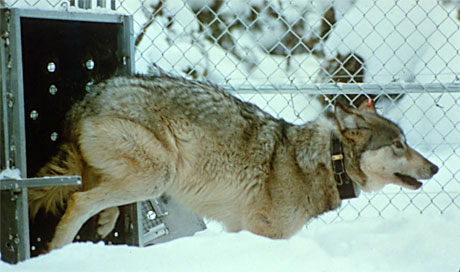Yellowstone Wolf: Tracking the Packs
The history of wolves in Yellowstone
By 1926, as a result of federal and state predator control efforts, gray wolves (Canis lupus) were officially extirpated from Yellowstone National Park, WY. In the ensuing decades, our understanding of large predators and their role in healthy ecosystems changed, and Northern Rocky Mountain wolves were eventually listed under the Endangered Species Act (ESA) in 1973.
With ESA listing came the goal of restoring wolves to their historic range, and in 1995 and 1996, following many years of public planning and input, a total of 31 wolves, captured in Alberta and British Columbia, Canada, were reintroduced to Yellowstone. Wolves flourished amidst Yellowstone's abundant prey and expansive, protected wilderness.
Wolf reintroduction in Yellowstone was part of the much larger Northern Rocky Mountain wolf recovery effort. This included a simultaneous wolf reintroduction in central Idaho and ongoing protection for a naturally recovering population in northwest Montana.
By 2002 the US Fish and Wildlife Service's recovery goals were met: the Northern Rockies were now home to 30 breeding wolf pairs, uniformly distributed throughout these three Rocky Mountain recovery areas for three successive years.
Delisting in Montana and Idaho took place in 2009, followed by a brief relisting, and final delisting throughout Montana, Idaho, and Wyoming in 2011 and 2012. While Yellowstone's portion of the wolf population remains protected within its boundaries, a regulated wolf hunting and trapping season now takes place throughout Montana, Idaho, and Wyoming, including in areas adjacent to the National Parks.

Photo by NPS
To facilitate monitoring and research, all of the wolves brought from Canada were radio-collared before their release into Yellowstone. This tradition of research continues today; each year the Yellowstone Wolf Project puts out radio collars with the goal of maintaining radio contact with all wolf packs within the park.
The information collected during collaring and regular monitoring has allowed the Wolf Project to study survival, reproduction, dispersal and distribution, sociality and genetics, disease, and predation on ungulates.
Extensive annual summaries are supplied in the Wolf Project's Annual Reports (http://www.nps.gov/yell/naturescience/wolves.htm).

